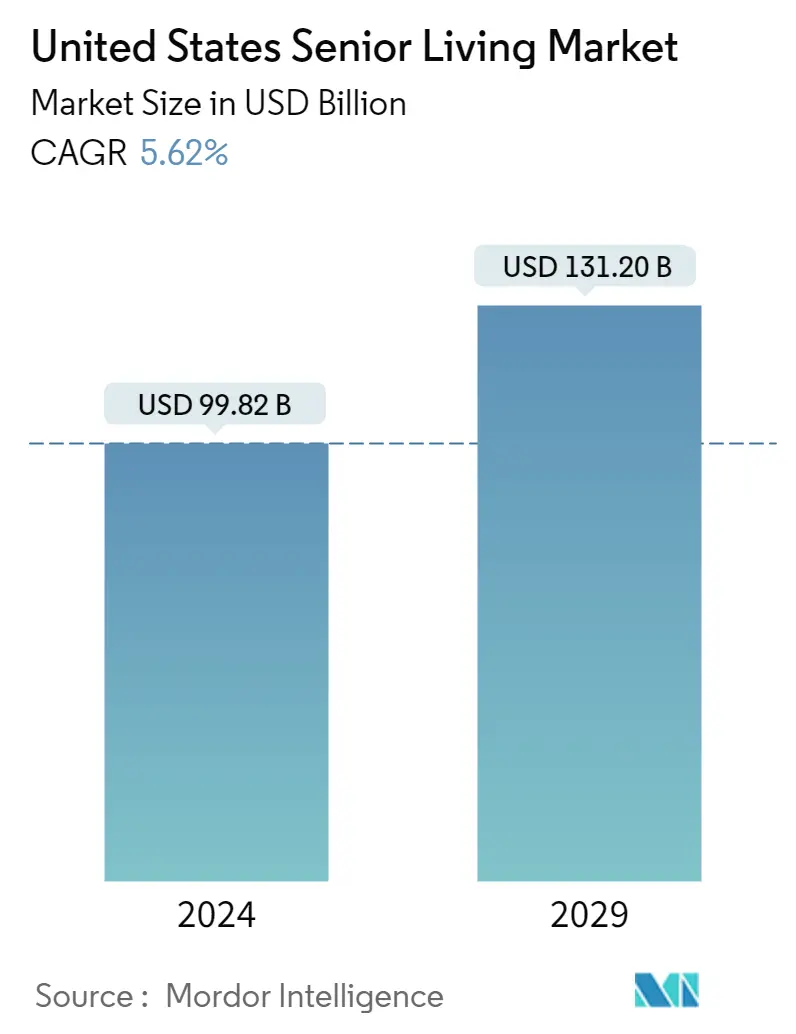Market Size of United States Senior Living Industry

| Study Period | 2019-2028 |
| Base Year For Estimation | 2022 |
| Market Size (2023) | USD 94.51 Billion |
| Market Size (2028) | USD 124.22 Billion |
| CAGR (2023 - 2028) | 5.62 % |
| Market Concentration | Low |
Major Players
*Disclaimer: Major Players sorted in no particular order |
Need a report that reflects how COVID-19 has impacted this market and its growth?
US Senior Living Market Analysis
The United States Senior Living Market size is expected to grow from USD 94.51 billion in 2023 to USD 124.22 billion by 2028, at a CAGR of 5.62% during the forecast period (2023-2028).
- Assisted living and independent living properties both experienced significant growth in occupancy rates, accounting for more than 80% and 70%, respectively. In addition, the market experienced the highest occupancy rates in San Jose (83.7%), Portland (83.4%), San Francisco (83.4%), etc. Also, low occupancy rates were noted in Houston (73.0%), Atlanta (74.8%), Las Vegas (74.9%), etc.
- Most of the senior housing communities are present in the Southeast region of the United States, with 3,706 communities, followed by West (3,436), Northeast (3,320), North Central (3,303), and South Central (2,244). The Southeast region includes North Carolina, South Carolina, Tennessee, Georgia, Florida, Alabama, Mississippi, Arkansas, Louisiana, and Texas.
- The Northeast region includes Maine, New Hampshire, Vermont, Massachusetts, Rhode Island, Connecticut, New York, New Jersey, and Pennsylvania. The West region comprises Montana, Idaho, Wyoming, Colorado, New Mexico, Arizona, Utah, Nevada, California, Oregon, Washington, Alaska, and Hawaii.
US Senior Living Industry Segmentation
The US senior living market provides a wide range of housing and lifestyle options suitable for the needs of an aging population.
The report on the US senior living market includes market dynamics, technological trends, insights, and government initiatives related to the market. The report covers segmentation by property type (assisted living, independent living, memory care, nursing care, and other property types) and key states (New York, Illinois, California, North Carolina, Washington, and the Rest of the United States). The report offers market size and forecasts for the United States Senior Living market in value (USD billion) for all the above segments.
| By Property Type | |
| Assisted Living | |
| Independent Living | |
| Memory Care | |
| Nursing Care | |
| Other Property Types |
| By Key States | |
| New York | |
| Illinois | |
| California | |
| North Carolina | |
| Washington | |
| Rest of United States |
United States Senior Living Market Size Summary
The U.S. Senior Living Market is projected to experience substantial growth in the coming years. This expansion is primarily driven by a rise in the aging population and their healthcare needs. Assisted living and independent living properties are seeing significant increases in occupancy rates, with the highest rates noted in cities such as San Jose, Portland, and San Francisco. The majority of senior housing communities are located in the Southeast region of the U.S., followed by the West, Northeast, North Central, and South Central regions. The senior housing sector is becoming a popular choice for real estate investments, driven by the increasing life expectancy of the country's citizens. This necessitates more investments in senior housing to accommodate a longer-living population. The demand for nursing care is also escalating due to the aging baby boomer generation, which requires more health support and senior living communities. The U.S. Senior Living Market is fragmented, with high competition among small and local developers. Major market players are expanding their businesses through mergers, acquisitions, strategic partnerships, and launching new projects.
Explore MoreUnited States Senior Living Market Size - Table of Contents
-
1. MARKET INSIGHTS AND DYNAMICS
-
1.1 Market Overview
-
1.2 Market Dynamics
-
1.2.1 Market Drivers
-
1.2.2 Market Restraints
-
1.2.3 Market Opportunities
-
-
1.3 Insights into Technological Innovation in the Senior Living Sector
-
1.4 Government Regulations and Initiatives
-
1.5 Supply Chain/Value Chain Analysis
-
1.6 Industry Attractiveness - Porter Five Forces Analysis
-
1.6.1 Threat of New Entrants
-
1.6.2 Bargaining Power of Buyers/Consumers
-
1.6.3 Bargaining Power of Suppliers
-
1.6.4 Threat of Substitute Products
-
1.6.5 Intensity of Competitive Rivalry
-
-
1.7 Impact of COVID-19 on the Market
-
-
2. MARKET SEGMENTATION
-
2.1 By Property Type
-
2.1.1 Assisted Living
-
2.1.2 Independent Living
-
2.1.3 Memory Care
-
2.1.4 Nursing Care
-
2.1.5 Other Property Types
-
-
2.2 By Key States
-
2.2.1 New York
-
2.2.2 Illinois
-
2.2.3 California
-
2.2.4 North Carolina
-
2.2.5 Washington
-
2.2.6 Rest of United States
-
-
United States Senior Living Market Size FAQs
How big is the United States Senior Living Market?
The United States Senior Living Market size is expected to reach USD 94.51 billion in 2023 and grow at a CAGR of 5.62% to reach USD 124.22 billion by 2028.
What is the current United States Senior Living Market size?
In 2023, the United States Senior Living Market size is expected to reach USD 94.51 billion.
